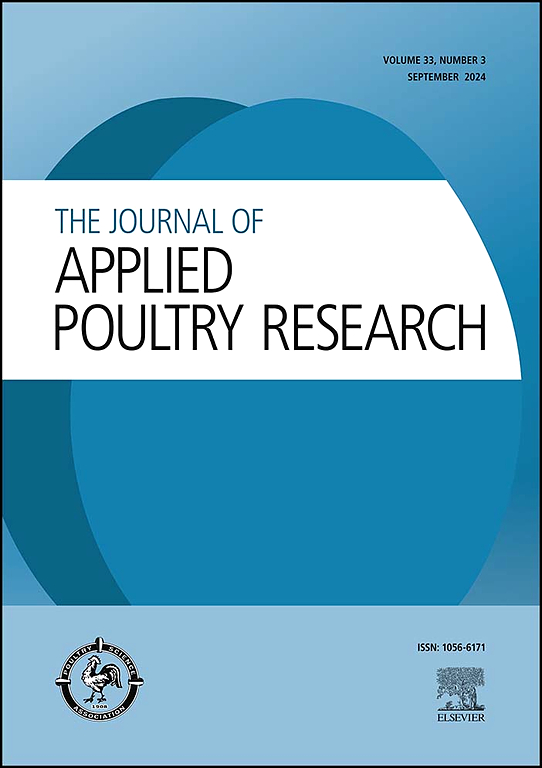Reliability of Palpation using three-dimensional keel bone models
IF 2
3区 农林科学
Q2 AGRICULTURE, DAIRY & ANIMAL SCIENCE
引用次数: 0
Abstract
Keel bone damage (KBD), including both deviations and fractures, is an important and wide-spread animal welfare problem of laying hens especially in non-cage housing systems. Diagnosis of its prevalence is the first step in finding solutions. The aim of this study was to increase the reliability of diagnosis of KBD by palpation using three-dimensional (3D) keel bone models. An online training session was organized about how to use 3D models of 3 different severity levels of keel bone damage as a tagged tactile analogue scale. After the online training took place, the participating groups were asked to score the keel bone damage levels of 20 laying hens at each of their respective facilities with and without using the models (40 hens in total) on a continuous scale. The repeatabilities of the scoring results of 37 people from 11 groups (countries) were computed with the R-package rptR to test whether the use of models increased the reliability of the scores. In general, the repeatabilities of the scores on a continuous and a binary scale were low. Contrary to expectations, the use of 3D models did not increase the reliability in scoring KBD by palpation. In future studies with these models, a more even distribution of KBD among groups and on-site instead of online training might give more reliable results.
三维龙骨模型触诊的可靠性
龙骨损伤(KBD),包括偏离和骨折,是蛋鸡普遍存在的一个重要的动物福利问题,特别是在非笼养系统中。诊断其流行程度是找到解决办法的第一步。本研究的目的是通过使用三维(3D)龙骨模型触诊来提高大骨节病诊断的可靠性。组织了一个在线培训课程,关于如何使用3种不同严重程度的龙骨损伤的3D模型作为标记的触觉模拟量表。在线培训结束后,参与小组被要求对各自设施的20只蛋鸡的龙骨损伤水平进行连续评分,使用和不使用模型(总共40只鸡)。采用R-package rptR对来自11个组(国家)的37人的评分结果的可重复性进行计算,以检验模型的使用是否增加了评分的可靠性。一般来说,连续和二元量表得分的可重复性较低。与预期相反,使用3D模型并没有增加触诊评分KBD的可靠性。在未来使用这些模型的研究中,更均匀地在群体中分布大骨节障碍,并且现场培训而不是在线培训可能会得到更可靠的结果。
本文章由计算机程序翻译,如有差异,请以英文原文为准。
求助全文
约1分钟内获得全文
求助全文
来源期刊

Journal of Applied Poultry Research
农林科学-奶制品与动物科学
CiteScore
4.10
自引率
10.50%
发文量
80
审稿时长
104 days
期刊介绍:
The Journal of Applied Poultry Research (JAPR) publishes original research reports, field reports, and reviews on breeding, hatching, health and disease, layer management, meat bird processing and products, meat bird management, microbiology, food safety, nutrition, environment, sanitation, welfare, and economics. As of January 2020, JAPR will become an Open Access journal with no subscription charges, meaning authors who publish here can make their research immediately, permanently, and freely accessible worldwide while retaining copyright to their work. Papers submitted for publication after October 1, 2019 will be published as Open Access papers.
The readers of JAPR are in education, extension, industry, and government, including research, teaching, administration, veterinary medicine, management, production, quality assurance, product development, and technical services. Nutritionists, breeder flock supervisors, production managers, microbiologists, laboratory personnel, food safety and sanitation managers, poultry processing managers, feed manufacturers, and egg producers use JAPR to keep up with current applied poultry research.
 求助内容:
求助内容: 应助结果提醒方式:
应助结果提醒方式:


